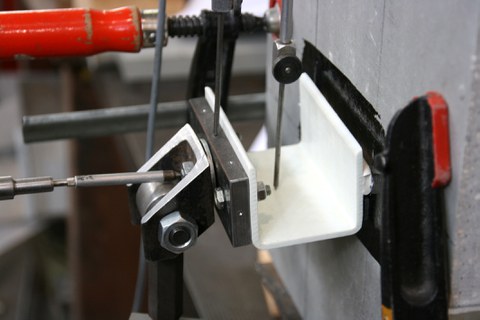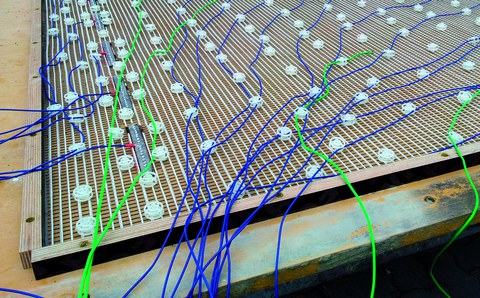Load-bearing concrete members with adaptive heating structures made of carbon fibres for buildings with climate neutral energy strategy
Table of contents
Project data
| Titel | Title Klimaneutrale Strahlungsheizung aus Textilbeton − Entwicklung von tragenden Textilbetonbauteilen mit adaptiven Heizstrukturen aus Kohlenstofffasern für klimaneutrale Gebäudeenergiekonzepte | Climate neutral radiant heater made of TRC – Development of load-bearing concrete members with adaptive heating structures made of carbon fibres for buildings with climate neutral energy strategy Förderer | Funding Bundesministerium für Wirtschaft und Energie (BMWi); Projektträger: AiF Projekt GmbH Zeitraum | Period 06.2012 – 08.2015 Leiter | Project Manager Dr.-Ing. Frank Schladitz Bearbeiter | Contributors Dipl.-Ing. Karoline Holz, Dipl.-Ing. Elisabeth Schütze Projektpartner | Project Partners Qpoint GmbH, Dresden | SGB Steuertechnik GmbH, Leipzig | HFB Engineering GmbH, Leipzig | Variotec GmbH & Co. KG + IEM Forstner, Neumarkt i. d. Oberpfalz | Architekturinstitut der HTWK Leipzig, FG Energiedesign |
Report in the yearbook 2015
The façade element of the future

Examination of the glued connection between FRP profile and TRC slab
From the need to use resources efficiently and to minimize energy consumption, the idea of developing load-bearing textile reinforced concrete elements with an integrated heating function comes into mind. Besides load bearing capabilities, carbon fibres are also electro conductive. If one applies power to a carbon reinforcement, one part of such power would be transformed into thermal energy because of the resistivity of the carbon. These heated panels give off radiant heat into an indoor area, which is comfortable if the indoor temperatures are relatively low.
In the past three years, several research projects were carried out for the planned façade panels. The use of hybrid textile reinforcement consisted of carbon fibres, in the main bearing direction (warp direction) and of alkali resistant glass fibres, in the cross direction. A large number of mechanical tests were made to determine the tensile strength and the bond behaviour under different temperatures. Out of these tests, characteristic values for the material properties were determined for the design of the panel.
The ultimate load-bearing capacity of the so called “smarttex board” was tested in a façade testing facility to prove the resistance against wind suction load. The dimensioning load was borne without a sign of damage. To determine the load-bearing capacity of the joint between GRP profiles and the textile reinforced concrete slab, many tests were made. The joint showed quite big reversible deformations.
A room-enclosing façade element has to fulfil fire protection requirements. Thus, the panel had to be classified into a fire-resistance class by fire tests. Several construction variants of the panel were tested. The critical result of the fire test was the time elapsed to failure. With the use of polypropylene fibres, the fire resistance was increased.
Lastly, the behaviour of the panels was observed under real conditions. Therefore, the panel was placed in a post-and-beam construction at a building at the Leipzig HTWK. Subsequently, monitoring of the panel was done to observe the influence of environmental conditions and of the heating power. The final results are still pending.
Report in the yearbook 2014
Clever heating with smarttex

Wired textile before casting a smarttex-board
In the future, we will need to construct in a much more resource-efficient manner. One of the fundamental points will be a functionally integrated way of construction, where several functions will be combined in one structural element. Here, the high-tech material, carbon concrete, can be efficiently used because of its good electrical conductivity. The electrical resistance of carbon is utilised to generate heat, allowing the use of a carbon concrete element surface for radiation heating. When such elements are integrated into the building scope, they can be used to heat the building. The application of these elements minimizes the use of material as well as the extent of other heating installation equipment and associated engineering design, yet resulting in a high level of comfort for both the user and the operator.
The functionality of the carbon concrete heating elements has been proven in several small-scale tests. In order to put the concept into practice, an experimental model was developed. In December 2014, the model was attached to an experimental construction at HTWK Leipzig.
In a post-and-beam facade, one of the glass elements was exchanged for the smarttex-board developed in the project. This board consists of two 22 mm thin carbon concrete slabs connected via GRP-profiles. An insulation layer, consisting of vacuum insulation panels, is arranged in between. The inner carbon concrete shell is reinforced with a heating textile, fabricated by applying electrical contacts to the carbon yarns in the textile. This textile is divided into four zones, which can be controlled individually with a touch panel. In order to monitor the function of the smarttex-board and to guarantee the operational safety, several temperature sensors were installed close to the textile, collecting data. If the operating temperature limit is exceeded, the power supply will be interrupted instantly.
For supervising the building ambient conditions, additional sensors for measuring temperature and humidity are integrated into the layer structure of the smarttex-board. The collected data can be retrieved from the touch panel, making the operating function of the smarttex board accessible for every user.
Report in the yearbook 2013
Ideal Conditions for Comfort

Taking a picture of the temperature development with an infrared camera.
Buildings of the future are to be characterised by energy and resource efficiency. This can be achieved by applying textile reinforced concrete in construction. Here, the obvious choice for reinforcement is the high-performance material carbon. The ability of carbon to generate heat, caused by its electric conductivity and resistance, allows the use as heat source in addition to the use for load transmission. The heat spreads across the element and the concrete surface acts as a radiant heater.
The practicability of this concept was tested on small format specimens, which were reinforced with a specifically interconnected hybrid textile of yarns made of alkali resistant glass and carbon. In this context, the influence of concrete moisture and concrete cover as well as the level of applied voltage on the temperature development were studied. As expected, the power generated by the varying electric tension proved to be the decisive factor. A rise in power results in a disproportionate rise in temperature. The concrete moisture, on the other hand, has a rather negative impact. In particular water saturated samples heated up considerably slower. However, this is a disadvantage which should be irrelevant for the future structural component. The concrete cover plays only a minor role.
The results were successfully compared with the simulation of an appropriate radiant heating model. The software which has been developed further specifically for this simulation shall be used to determine the required heat output for indoor environmental comfort in the future. Furthermore, heating zones which can be individually controlled will make the individual provision of heating energy based on the demand possible.
A comparison of the heat output that can be reached with a radiant heater and with an air source heat pump showed that the latter is advantageous both ecologically and economically for heating requirements of 15 to 50 kWh per square meter per year. Many new construction projects will be in this range. Thus the experiments in combination with the simulation show the potential of radiant heaters made of textile reinforced concrete.
Report in the yearbook 2012
Heatable TRC

Interconnected textile section
Current problems in the construction industry, such as the increase in energy consumption and the associated increased requirements for the building envelope, call for innovative measures and the exploration of new heating concepts. One of them is the application of radiant heaters. Unlike conventional heating devices they transfer heat directly to the human body through thermal radiation. That way already low room temperatures are found to be pleasant and a comfortable environment can be achieved in little or unheated rooms within a short period of time.
To combine such advanced heating concepts with state-of-the-art construction methods the application of the innovative building material TRC comes to mind. Textile reinforcement can be realized in a variety of fibre materials. Carbon as one of them does not only have excellent mechanical properties but is also a very good electrical conductor. This enables one to use a TRC slab not only in its load carrying function but also as radiator by applying voltage to the carbon fabric. The electrical resistance heats the carbon and thus the entire element. The textile can be positioned precisely within the slab and requires only very little concrete cover, so that such a radiant heater does have short response times despite the thermally inert concrete. That makes even an occupancy controlled heating surface conceivable. If successful, it would be sufficient to heat a space only if this is actually necessary, which contributes to a reduction of energy consumption. Combining such heating elements for instance with very thin vacuum insulated panels leads to sandwich structures with a significantly reduced total thickness compared to ferroconcrete sandwich panels of similar functionality. Another potential application is the use of heated TRC panels for the bracing of lightweight constructions.
To achieve these objectives, problems in a wide field of research have to be solved. In addition to studies of the mechanical properties under varying temperatures and of the conductivity of carbon, an electrical insulation of the yarn under low voltage is necessary to obtain an element free of leakage current. Furthermore technologies for the interconnection of the textile reinforcement and for occupancy control need to be developed and adapted.
